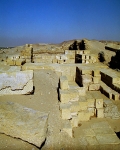Kom el Atl
Archaeology »
Archaeological Monuments » Kom el Atl
Kom el Atl - Egypt
Kom el Atl is located in Karanis,Faiyum.
Kom el Atl monument was established on 3rd century BC.
Primary threats to Kom el Atl :
There are also remains of a huge well-constructed mudbrick structure, once thought to have been the town’s temple. Many papyri were found here in the archive of Horos and Tapekysis.
Historical facts of Kom el Atl :
- Kom el Atl is an archaeological site located in Egypt, specifically in the ancient city of Alexandria. It holds great historical significance and provides valuable insights into the rich cultural heritage of the region. The site has been the subject of extensive excavations, shedding light on various aspects of ancient Egyptian civilization. Here are some historical facts about Kom el Atl:
- Ancient Origins : The history of Kom el Atl dates back to the Hellenistic period, which began after the death of Alexander the Great in 323 BCE. It was during this time that the city of Alexandria was founded by Alexander's general, Ptolemy I. The area around Kom el Atl was inhabited by Greeks and other foreign settlers.
- Royal Necropolis : Kom el Atl served as a royal necropolis, a burial place for the Hellenistic and Roman period rulers of Egypt. The tombs in this area were elaborate and adorned with rich decorations, reflecting the opulence and grandeur of the ruling elite.
- Influential Figures : Many notable figures from the Ptolemaic and Roman eras were buried in the tombs of Kom el Atl. Among them was Cleopatra VII, the last ruler of the Ptolemaic dynasty and one of the most famous queens in history. However, the exact location of Cleopatra's tomb remains a mystery, and no conclusive evidence has been found linking her to Kom el Atl.
- Architectural Features : The tombs at Kom el Atl exhibit a combination of Egyptian, Greek, and Roman architectural styles. They feature imposing facades, intricate carvings, and detailed reliefs that depict various mythological and religious scenes.
- Rediscovery : The site of Kom el Atl was rediscovered in the early 20th century by French archaeologists. Excavations revealed a vast necropolis with multiple chambers and interconnected passages. The discovery of numerous sarcophagi and burial artifacts added to the understanding of ancient burial practices and funerary rituals.
- Artifacts and Treasures : The excavations at Kom el Atl unearthed a wealth of artifacts, including intricately decorated pottery, jewelry, statues, and funerary masks. These objects provide valuable insights into the artistic and cultural achievements of the Hellenistic and Roman periods.
- Influence on Alexandria : The discovery of Kom el Atl and its royal necropolis has deepened our understanding of the ancient city of Alexandria. It showcases the complex and multicultural nature of the city, which was a melting pot of various cultures and traditions.
- Importance to Archaeology : Kom el Atl has played a crucial role in advancing our knowledge of ancient Egypt. The tombs and artifacts found at the site have provided valuable information about the religious beliefs, burial practices, and artistic styles of the Hellenistic and Roman periods.
- Preservation Efforts : Due to its historical importance, efforts have been made to preserve and protect the site of Kom el Atl. Archaeological teams continue to study the area, ensuring that the remains are safeguarded for future generations.
- Visitor Experience : Today, visitors can explore Kom el Atl and witness the magnificence of the ancient tombs. The site offers a unique glimpse into the past, allowing visitors to appreciate the historical legacy of Alexandria and the contributions of its ancient rulers.
- In conclusion, Kom el Atl is a significant archaeological site that holds a wealth of historical facts about ancient Egypt. Its royal necropolis, architectural features, and the artifacts discovered there provide valuable insights into the cultural, artistic, and religious aspects of the Hellenistic and Roman periods. The site continues to captivate archaeologists, historians, and visitors alike, preserving the legacy of Alexandria's rich past.

